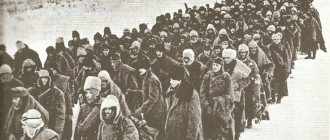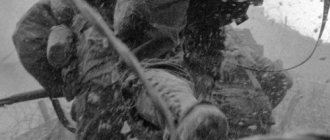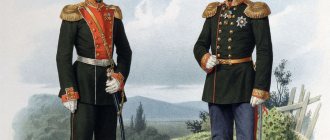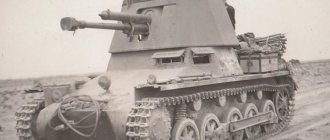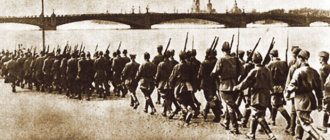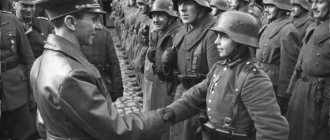All about weapons
Today we will compare the standard summer combat equipment of soldiers of the Wehrmacht and the Soviet Union for the summer of 1941. For each item, points will be calculated, based on this we will find out which equipment was the best.
I want to say right away that everything written is my subjective opinion and no one is imposing it.
Enjoy watching!
Form
The Soviet soldier wore a tunic and riding breeches of the 1935 model. Material: cotton fabric Pockets: 2 pieces on the chest There are elbow pads made of a double layer of fabric. Color: khaki The shape “breathed” perfectly and did not overheat
The German soldier wore a tunic and riding breeches of the 1940 model. Material: woolen fabric Pockets: 4 pieces (on the chest and on the belt) Internal lining made of cotton fabric is sewn on. Color: gray The uniform quickly overheated in the sun, which is why most soldiers constantly rolled up their sleeves, which can be seen in many photos.
Conclusion: The Red Army gets 1 point for a successful version of the summer uniform.
Shoes
Soviet soldiers mostly wore yuft boots or boots with wraps.
The Germans also wore boots or ankle boots Schnurschuhe model 1940
Conclusion: In principle, everything is clear about shoes, both of them wore similar things, however, if you look in addition to shoes, you can see that in the German army, in addition to foot wraps, they already wore socks at that time. So well-deserved points for the Wehrmacht.
Headdress
Soldier's cap of the Red Army
Wehrmacht soldier's cap
Conclusion: In terms of headdress, I think the Red Army wins again. The material is exactly the same as the mold. As a result, in the summer, the garment does not overheat, unlike wool.
Belt
Red Army soldiers wore leather belts.
Wehrmacht soldiers wore a leather belt with a buckle on which the coat of arms and the inscription “Gott mit uns” - “God is with us” are depicted.
Conclusion: the German belt undoubtedly wins due to its convenient quick release function. This allows the soldier to quickly discard all equipment. Plus, a lot of Soviet soldiers wore German belts, cleaning the badge of German symbols in advance, applying a red star.
Unloading systems and pouches
The Soviet soldier's unloading system included:
- Cartridge bag (Each compartment holds four clips or 10 loose rounds)
- Aluminum flask
- Small infantry shovel
- Spare cartridge bag
- Grenade bag
- Grocery bag
- Gas mask bag
- Shoulder straps
- Grocery bag
- Bowler
The German soldier's unloading system included:
- Y-shaped shoulder straps
- Black Leather Ammo Pouches (Each compartment holds two five-round clips of 7.92mm, for a total of 30 rounds per pouch)
- Schanzzeug mining shovel
- Gas tank with gas mask M-38
- Camouflage fabric tent
- Aluminum flask M-31 with mug
- Pouch 1931 model (Suharka)
- Bowler
- Bag with Himnakki
Conclusion: Soviet equipment has a larger number of bags, which allows you to carry more ammunition and food, but it is not possible to quickly dump all this. Unlike the German unloading, most of which are attached to the belt and straps. In this regard, it turns out to be a draw.
Duffel bags
The Soviet fighter used the 1930 model "Sidor" duffel bag or the 1939 model backpack
The German used the 1939 and 1934 model backpack or the Assault backpack
Conclusion: The Soviet backpack of 1939 was significantly smaller than the Sidor, therefore, it carried less ammunition. German backpacks were larger than Soviet ones and had different pockets, which made it possible to properly distribute things. Plus, German backpacks were attached to shoulder straps, which was undoubtedly convenient on the march or in case of a quick release. 1 point for the Germans.
Helmet
SSH-40 Made from steel with the addition of nickel and silicon. Thickness 1.9 mm
M-35
Made from sheet carbon steel. Thickness 1.15 mm
Conclusion: The Soviet helmet has thicker steel, therefore it has a greater chance of being protected from shrapnel and pistol bullets. 1 point for the Red Army
Weapon
Vitovka Mosin
Adopted into service in 1891. Five-shot. Caliber 7.62 mm. Weight 4.5 kg. Length 1.38 meters. Sighting range 2000 meters.
The following were installed on the Mosin rifle as additional accessories:
- Sniper scope PU 3.5x22
Kark 98k rifle
Adopted into service in 1935. Throughout the war it was the most popular Wehrmacht rifle. Caliber 7.92 mm. Weight 3.8 kg. Length 1.10 meters. Sighting range 1500 meters.
The following additional accessories were installed on the Kark 98k:
- muzzle grenade launcher
- Curved barrel for shooting from behind cover
- Sniper scope ZL-39
Conclusion: The Mosin rifle outperforms the German rifle in terms of firing range, but is clearly inferior to the Kark in terms of length and weight. In the event of a direct collision, the German rifle wins due to its maneuverability, but in the case of a positional attack, the Mosinka wins in terms of firing range. Draw.
Knives
A tetrahedral carbon bayonet for the Mosin rifle.
Total length: 500 mm
Blade length: 430 mm
Blade width: 15 mm
Seitengewehr 84/98 bayonet, model 1915. Made from Zolipgen steel.
Total length: 380 mm
Blade length: 250 mm
Blade width: 25 mm
Conclusion: a tetrahedral bayonet is useful in bayonet attacks only for piercing blows, while the German one can deliver both piercing and cutting blows. As a result, the Soviet army still abandoned the tetrahedral model towards the German model for the future AK-47.
1 point for the German bayonet.
Result: German equipment wins with a score of 6/5.
The Special Forces of the World were with you! Thanks for viewing this article, I hope you found it interesting!
This article shows that, contrary to general opinion, the equipment of the Soviet soldier was not very different from the German one, but on the contrary, in some aspects, it was even better! All this, together with the enormous will to Victory and further improvements in the equipment of the Red Army soldiers, helped win the war against a very strong and intelligent enemy.
